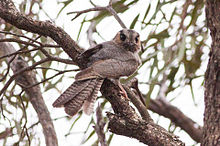Apodimorphae
| Apodimorphae | |
|---|---|
 | |
| Australian owlet-nightjar, Aegotheles cristatus | |
 | |
| Common swift, Apus apus | |
| Scientific classification | |
| Domain: | Eukaryota |
| Kingdom: | Animalia |
| Phylum: | Chordata |
| Class: | Aves |
| Clade: | Strisores |
| Clade: | Vanescaves |
| Clade: | Apodimorphae Sibley et al., 1988 |
| Subtaxa | |
| |
Apodimorphae is a clade of strisorean birds that include the extant families Trochilidae (hummingbirds), Hemiprocnidae (treeswifts), Apodidae (swifts), and Aegothelidae (owlet-nightjars), as well as many fossil families. This grouping of birds has been supported in a variety of recent studies.[1][2][3][4][5][6] There are two higher classification schemes that have been proposed for the apodimorph families. One is all strisorean birds are classified in the order Caprimulgiformes,[3][5] while the other is the strisorean birds are split into several distinct orders. In this case Apodimorphae is a subclade of Strisores that includes the orders Aegotheliformes (only including the owlet-nightjars of Australasia) and the Apodiformes (the swifts, treeswifts, and hummingbirds which have a global distribution).[2][4][6] A similar name for the group Daedalornithes[1] has been used for the owlet-night-apodiform clade, there is a difference between the two names with Apodimorphae defined as the total-group (the most inclusive clade including Aegotheles cristatus and Apus apus but not Caprimulgus europaeus, Steatornis caripensis, Nyctibius grandis, or Podargus strigoides) and Daedalornithes defined as the crown group (the least inclusive clade including Aegotheles cristatus and Apus apus).[6]
References[edit]
- ^ a b Sangster, George (2005). "A name for the clade formed by owlet-nightjars, swifts and hummingbirds (Aves)". Zootaxa. 799 (1): 1–6. CiteSeerX 10.1.1.193.2189. doi:10.11646/zootaxa.799.1.1.
- ^ a b Cracraft, Joel (2013), "Avian higher-level relationships and classification: Nonpasseriforms", in Dickinson, Edward C.; Van Remsen, James Jr. (eds.), Non-passerines, The Howard and Moore Complete Checklist of the Birds of the World, vol. 1 (4th ed.), Eastbourne, UK: Aves Press, pp. xxi–xliii, ISBN 9780956861108
- ^ a b Jarvis, Erich D.; et al. (2014). "Whole-genome analyses resolve early branches in the tree of life of modern birds". Science. 346 (6215): 1320–1331. Bibcode:2014Sci...346.1320J. doi:10.1126/science.1253451. PMC 4405904. PMID 25504713.
- ^ a b Prum, Richard O.; Berv, Jacob S.; Dornberg, Alex; Field, Daniel J.; Townsend, Jeffrey P.; Lemmon, Emily Moriarty; Lemmon, Alan R. (2015). "A comprehensive phylogeny of birds (Aves) using targeted next-generation DNA sequencing". Nature. 526 (7574): 569–573. Bibcode:2015Natur.526..569P. doi:10.1038/nature15697. PMID 26444237. S2CID 205246158.
- ^ a b Reddy, Sushma; et al. (2015). "Why do phylogenomic data sets yield conflicting trees? Data type influences the avian tree of life more than taxon sampling". Systematic Biology. 66 (5): 857–879. doi:10.1093/sysbio/syx041. PMID 28369655.
- ^ a b c Chen, Albert; White, Noor D.; Benson, Roger B. J.; Braun, Michael J.; Field, Daniel J. (2019). "Total-evidence framework reveals complex morphological evolution in nightbirds (Strisores)" (PDF). Diversity. 11 (9): 143. doi:10.3390/d11090143.


 French
French Deutsch
Deutsch